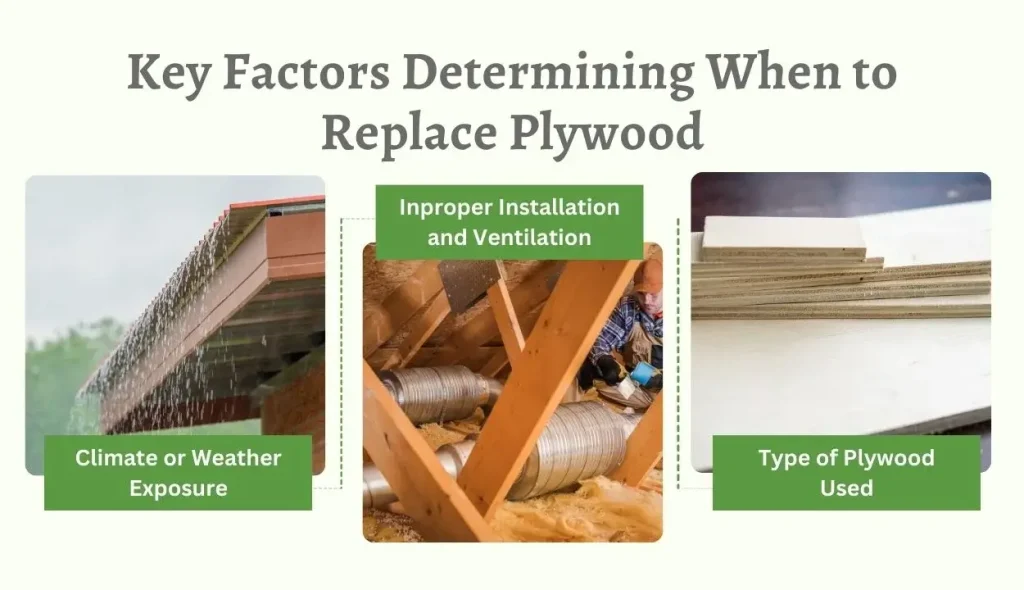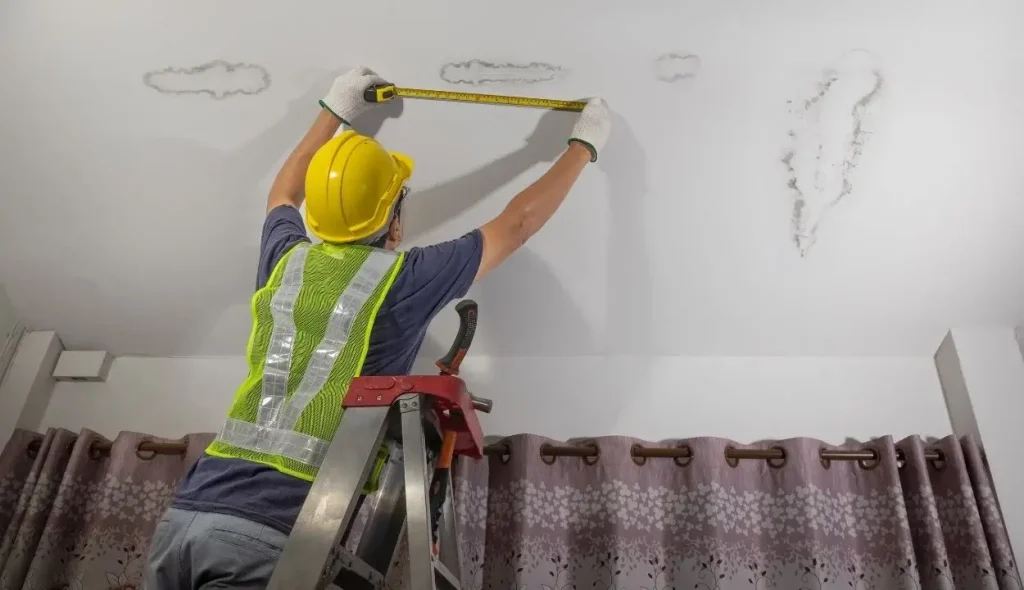Introduction
Do you want to know when to replace plywood on roof? Are you noticing bad signs that your roof is deteriorating?
Areas that are sagging, waterstains, or wood feeling soft and spongy could indicate underlying damage to the plywood sheathing. It’s crucial to address these plywood issues properly.. Neglecting problems allows risks of further deterioration and it bocome more costly to repair.
When to replace Plywood on roof?
Replace plywood roof sheathing if you notice visible damage like sagging areas, cracks, moisture stains or rot. Even without visible issues, consider replacement if plywood exceeds 15-20 years old due to age-related deterioration.
Finally, always replace compromised sections when pursuing a full roof replacement, as removing old materials allows proper inspection and replacement access.
Costs of Replacing Roof Plywood
| Plywood Thickness | Material Cost (per sq.ft.) | Contractor Labor Cost (per sq.ft.) | Square Feet Area | Total Cost |
|---|---|---|---|---|
| 1/2″ CDX | $0.60 – $0.90 | $3 – $5 | 2000 sq.ft. | $10,000 – $18,000 |
| 5/8″ CDX | $0.75 – $1.10 | $3 – $5 | 2000 sq.ft. | $12,000 – $20,000 |
| 3/4″ T&G CDX | $1.00 – $1.50 | $3 – $5 | 2000 sq.ft. | $16,000 – $24,000 |
This table provides the total cost estimates for different plywood thicknesses based on a 2000 square feet area, considering both material and contractor labor costs.
Signs to Replace Plywood on Roof

Visible Damage or Deterioration
A physical inspection looking for signs of failure is critical. When walking on the roof, take note of any areas feeling soft, spongy or sagging underfoot.
Other visible red flags are cracks, splits, holes or warping in the plywood itself. This advanced deterioration compromises structural integrity. Also look for any water stains, wood rot, mold or mildew growth signaling moisture penetration and plywood damage.
Roof leakage
During heavy rainfall, check both the attic and rooms below for any active leaks penetrating through the roof deck. Even if no dripping is observed currently, take note of any existing water stains on ceilings as evidence of past leaks.
These leak points could signal vulnerable areas where plywood sheathing has been moisture damaged from past water intrusion. Leak sources require further investigation and likely plywood replacement in those areas at minimum.
Age of Plywood
The age of plywood sheathing is a major determining factor for replacement needs. Most building sources cite a typical plywood lifespan of 10-30 years depending on environmental conditions before deterioration necessitates replacement.
As a general guideline, roofs over 15 years old warrant more frequent, thorough inspections. The risk of advanced age-related deterioration increases substantially beyond 20 years.
Once a plywood roof deck hits 25-30 years, full replacement should be strongly considered even without visible signs of failure yet.
Key Factors Determining When to Replace Plywood

Climate or Weather Exposure
Hot, cold and wet climate extremes accelerate deterioration rates of plywood roof sheathing. Intense heat and humidity causes wood to expand, crack and degrade rapidly over repeated summer cycles.
In freezing winter conditions, trapped moisture within plywood expands as it freezes, slowly prying wood layers apart. And in damp, rainy environments the constant moisture exposure eventually overcomes wood treatments causing rot and compromise.
Roofs in these harsher weathering climates may require plywood replacement as frequently as every 10-15 years versus 25-30 year lifespans in moderate conditions. Closely monitoring impact of your local climate patterns is vital.
Inproper Installation and Ventilation
Improper roof installation and lacking adequate ventilation creates a highly vulnerable scenario for rapid plywood deterioration. When heat and humidity get trapped in the attic, it essentially cooks the plywood from above and below over time.
Sufficient intake vents low on the roof/soffits and exhaust vents near ridges allow crucial airflow to expel heat and water vapor. This continuous airflow keeps plywood drier and cooler, dramatically extending its lifespan.
Roofs with improper or insufficient ventilation are very susceptible to deterioration within 10-15 years or less in many cases. Verifying proper ventilation is an essential part of roof system design and longevity.
Type of Plywood Used
The wood species and manufacturing treatment process also plays a major role in overall durability and expected service life of roof plywood sheathing. Lower grade, untreated wood varieties understandably deteriorate far more rapidly than treated, moisture-resistant options.
The cost differences are relatively small, but higher-grade treated plywoods simply hold up better over decades of weathering. They are well worth the marginal extra upfront cost for the drastically longer lifespan versus basic untreated varieties.
| Wood Type | Typical Lifespan |
|---|---|
| Untreated | 10-15 years |
| Standard CDX | 15-25 years |
| Pressure-Treated | 25-30+ years |
Plywood roof Replacement Process
Roof Inspection
Whether you opt to inspect yourself or hire professionals, a thorough roof inspection is critical for assessing overall plywood condition and integrity. Roof inspectors have specific protocols they follow:
By thoroughly inspecting all components, problem areas within the plywood sheathing can be identified and marked for surgical replacement as needed versus full deck replacement.
Removing Old Plywood
Before any deteriorated sections of plywood roof decking can be removed and replaced, tear-off of existing shingles/underlayment must occur first. All overlying roof covering materials are systematically removed to expose the full deck surface.
Next, roofing contractors will use pry bars, sledgehammers, and other specialized tools to carefully remove just the compromised areas.
Throughout this process, roofing professionals must take precautions against causing any further damage or compromising the structural integrity of remaining roof components during targeted removals.
Installing New Plywood
With old deteriorated plywood fully cleared, new moisture-resistant CDX or OSB replacement panels can be installed. These are cut to size with circular saws or sawzalls to fit each section being patched.
Following proper board staggering patterns, new plywood sections get secured with specialized ring-shank nails or screws into the roof trusses/joists below at regular intervals along edges and middle spans according to local building codes.
Once new plywood replacements are firmly fastened, with seams sealed against moisture penetration, it restores full structural rigidity and integrity to the roof deck surface. This provides a fresh substrate ready for new roofing underlayment and finish layers to be installed atop.
DIY vs. Hiring a Professional

For many homeowners, the prospect of working at heights atop their roof to inspect or replace plywood sheathing raises understandable safety concerns. Falls from roof level can easily cause severe injury or worse.
Unless you have substantial prior experience and capabilities working at heights, it is generally advisable to hire licensed, insured roofing professionals to handle plywood roof deck repairs and replacements. Experienced roofers understand proper safety protocols and have necessary equipment like roof harnesses, scaffolding and fall-arrest systems.
For those with roofing expertise and an acceptable pitch roof within their capabilities, DIY plywood replacement can be an option to save on labor costs. But for complex roofs or average homeowners, professional contractors are strongly recommended.
How to prevent roof replacement

Proper Attic Ventilation
As discussed earlier, ensuring sufficient airflow and ventilation is absolutely vital for maximizing service life of roof plywood decking. Intake vents low on the roof draw in cooler outside air, while exhaust vents at peak allow built-up heat and moisture to escape.
This continual circulation of dry air not only keeps plywood cooler, but prevents moisture accumulation that rots wood over time. Most building codes require at least 1 sq. ft. of ventilation for every 150 sq. ft. of attic space to maintain adequate airflow.
Regular Roof Inspections
Rather than just reacting to visible roof failures, the wisest maintenance approach is adhering to a regular professional roof inspection schedule. Having a certified inspector examine all roof components every 3-5 years allows catching any plywood deterioration or other issues extremely early.
Addressing small problems like caulking cracks, replacing shingles or clearing drainage immediately prevents them from escalating into far larger repair expenses down the road. These preventative inspections maximize your roof’s full serviceable lifespan.
Leak/Damage Repair
When leaks or any roof damage is identified, no matter how minor it appears initially, repairs should be made promptly. Even a small persistent leak steadily rots surrounding plywood from repeated moisture exposure and freeze/thaw cycles.
By swiftly repairing any roof penetrations, caulking gaps, replacing damaged shingles/tiles and clearing drainage paths – you prevent that isolated issue from spreading to neighboring plywood and accelerating deterioration.
Conclusions
Plywood roof sheathing provides the critical foundation for your entire roofing system and home structure above. Remaining vigilant for warning signs like sagging areas, moisture stains, cracks or leaks that could indicate plywood deterioration is paramount.
While localized plywood repairs carry a meaningful price tag, they extend remaining roof longevity and protect your home from water infiltration and structural compromise. With proper ongoing maintenance and timely sheathing replacements, you maximize your roof’s full serviceable lifespan before complete re-roofing is required.
So heed your roof and have professionals inspect regularly. Catching deterioration early allows surgical plywood replacements that are a minor investment safeguarding your home’s structural integrity for years to come.
FAQ’s
How often should I inspect my roof’s plywood sheathing?
Aim for professional roof inspections every 3-5 years. In harsh climates, consider annual inspections to catch plywood issues early.
Can I replace roof plywood myself?
DIY is possible if you have roofing experience and a manageable pitch. Otherwise, hire professionals for safety and proper installation.
What causes plywood sheathing to deteriorate prematurely?
Poor attic ventilation, moisture exposure, improper installation, and low-grade untreated wood accelerate deterioration rates.
How much does it cost to replace roof plywood?
Typically $3-$8 per square foot for labor and materials. Prices vary based on accessibility, roof size/complexity and plywood quality.
When should I plan for full plywood deck replacement?
Consider full replacement if plywood exceeds 25-30 years old, even without visible damage yet. Older roofs are very prone to latent deterioration.

